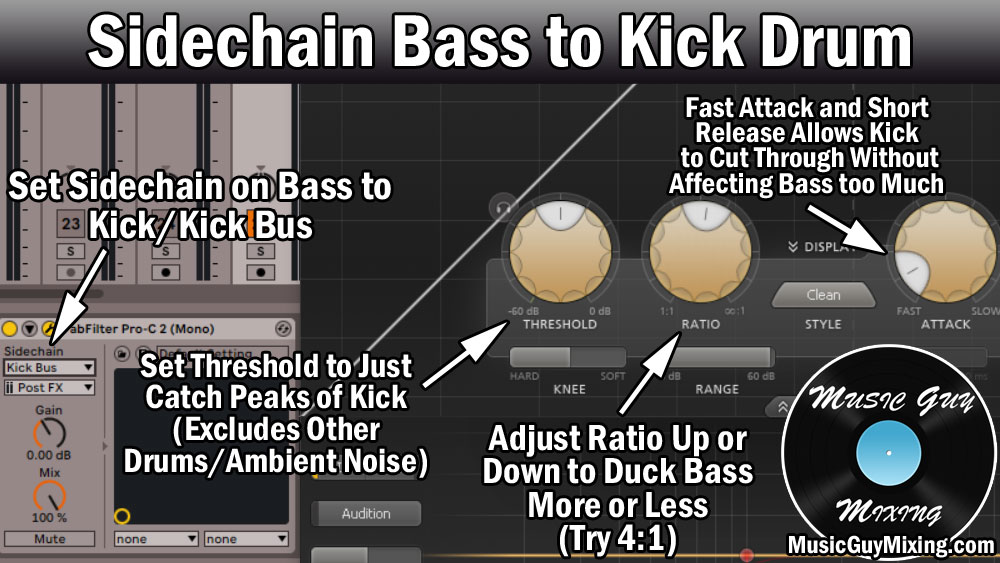Sidechain compression and sidechain EQ can each be used to affect one track’s behavior based on the behavior of a different track. Let’s talk the difference between sidechain compression vs sidechain EQ.
Sidechain Compression Vs Sidechain EQ
Let’s address each on their own to better explain the differences between sidechain compression and sidechain EQ, beginning with compression.

What is Sidechain Compression
First, as I explained in my tutorial on what is sidechain compression, this involves compressing one track based on the behavior of another.
I’ve talked about this again and again, but the most classic example of this is sidechaining your bass to your kick.
As I covered in my low end mixing tutorial, the bass and kick share the same fundamental or core frequency. Existing right on the fringe of the sub bass range, the kick drum’s fundamental typically exists between 50-70Hz, depending on the drum, tuning, etc.
As I showed in my audio panning guide, both the bass and the kick should be left in the center to remain consistent across the stereo field.
When you have two similar frequency instruments on top of each other in the stereo field and without the practical option of adding depth like the case with kick and bass, you get a conflict. One if not both of the instruments disappear and don’t have the presence they need.
Enter sidechain compression. This means that we drop a compressor on our bass and tell that compressor to use the kick’s behavior as the threshold.
When the kick triggers, the threshold on the bass compressor detects that signal and compresses the bass for that split second with the remaining settings we dialed into that compressor:

The bass ducks out when the kick triggers, giving the low end frequency spectrum completely to that thickness of the kick to play for that split second. This creates a cleaner low end with a well defined kick without noticeably sacrificing the bass.
It actually creates more dynamics in the bass, making it feel more alive as it gets pulled down for that split second then comes back to full force as per the release settings when the kick stops.
What is Sidechain EQ
What if we want to get a bit more surgical than ducking out an entire track? Enter sidechain EQ.
Sidechain EQ involves using a dynamic EQ to attenuate or boost a band based on the behavior of another track.
It’s exactly the same as sidechain compression in this regard, only it can allow for more transparent results while still accomplishing the same goal.
Note that not all EQ’s have sidechaining built in, in fact I just did a quick tutorial on how to use sidechain EQ in Ableton considering their stock EQ doesn’t have the ability.
My favorite EQ, FabFilter’s Pro-Q 3 (check out my FabFilter Pro-Q 3 review) makes it incredibly easy to make any filter (see EQ filter types) dynamic and sidechain it to another track.

The process of sidechain EQ is very similar to that of sidechain compression. In keeping with the bass to kick sidechaining example, we’re dropping the effect right on our bass, this time an EQ.
The difference is we’re designating the frequency and Q or width of the band (see my overview of the Q setting in EQ) which we want to attenuate or boost based on the behavior of our kick.
In this example, we’d locate the fundamental frequency of our kick, that thickest part in the 50-70Hz range, and set that as our band frequency on the EQ.
This gives us the benefit of just pulling down the fundamental frequency of the kick but on the bass.
We then set that band to be dynamic and use the sidechained source’s behavior (the kick in this case) as the threshold.
We can then adjust the threshold and dynamic gain range accordingly to tell the EQ how much to pull down the bass in that specific frequency range.
Again, I show the complete process of sidechain EQing your bass to your kick in my tutorial, but the advantage of this is that it leaves the rest of your bass untouched, even when the kick is playing.
Unlike sidechain compression which indiscriminately pulls down the entire frequency spectrum, in sidechain EQ the transients are left untouched (in this example).
Sidechain Compression Vs EQ – Which is Better
Both tools have their place in your mixes. When you need an entire track to get out of the way or you want to get some interesting aesthetic effects by having that compression engage based on another track, sidechain compression is the way to go.
When you want a more subtle and transparent ducking out of particular frequencies in a track like with our kick and bass example, sidechain EQ allows you to target specific frequencies to pull without sacrificing the entire frequency range.
Either way, both tools are useful for achieving a cleaner and less cluttered mix, regardless of how you use the stereo field and depth.
